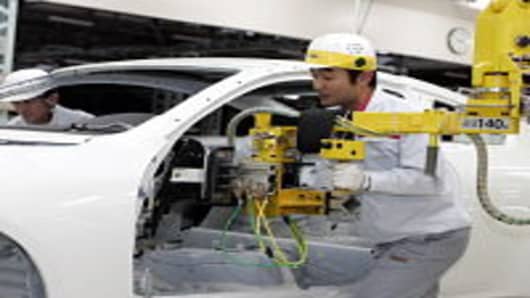When the financial crisis erupted in 2007, many observers reeled in shock as revelations emerged about the modern banking world. Never mind all those dodgy subprime loans; what really caused consternation was just how fiendishly complex and opaque finance had become.
More specifically, before 2007, bankers had created numerous convoluted, cross-border financial chains. And while these chains seemed to make the system more efficient and safer in good times, when disaster struck, they produced new risks which took investors by surprise.
But should some of those lessons from the world of finance be transposed to the global manufacturing sector? This question hangs over the markets as investors assess the longer-term impact of the Japanese disaster. During the past couple of decades, the role Japan plays in the global economy has shrunk in relative terms as its economy has stagnated while countries such as China have grown.
But Japan still plays an important role in some manufacturing supply chains, most notably in the auto and electronics sectors. The country, for example, produces about 30 percent of the world's flash memory (used in electronic cameras and smartphones) and around 15 percent of the D-Ram memory (used in PCs).
With many Japanese factories facing temporary or partial closure, the earthquake has left investors facing an uncomfortable truth: in the modern world, it can be tough to assess how convoluted cross-border linkages really work, in manufacturing as in finance.
Part of the problem is that the supply chains in many key manufacturing spheres increasingly hop across multiple borders. Last year, for example, the Asian Development Bank set about trying to assess how just one item, the iPhone, was made. This revealed a dazzlingly complex pattern, typical of numerous sectors. "Manufacturing iPhones involves nine companies, which are located in the PRC, the Republic of Korea, Japan, Taipei, China, Germany, and the US," the ADB observed, adding that "the major producers and suppliers include Toshiba, Samsung, Infineon, Broadcom, Numonyx, Murata and Cirrus Logic".
Now, in theory that dizzy patchwork of names and countries ought to imply that companies have plenty of choice about where to make things. In practice, however, competitive cost-cutting has forced companies to streamline their operations to such a degree that if something goes wrong with one step in their complex, cross-border supply chain, the entire system can break down. Moreover, since competing companies often end up streamlining their operations in very similar ways, this worsens the problem of bottlenecks and vulnerabilities. Strategies that look rational for individual manufacturing companies, in other words, can create big macro-level vulnerabilities, again, echoing a pattern seen in finance.
A couple of years ago, for example, the factory lines in European car manufacturers were halted for a period when problems erupted at an Asian factory that was the only source of thread for seat belts. Indeed, Zurich, the insurance group, has tracked more than 1,000 examples in the past five years where companies have quietly suffered because of disruption at a factory producing a critical component, or at a key transport stage.
Last year, the Business Continuity Institute published a survey of companies which suggested that three-quarters had experienced production hiccups in their supply chain in the previous 12 months, due to unexpected surprises (ranging from weather to health issues to earthquakes). A quarter said that problems were getting worse. "In the highly competitive, global market of recent years, many businesses implemented cost-saving strategies to maintain profit margins, including just-in-time deliveries of critical resources and components," says Nick Wildgoose, supply chain product manager at Zurich. "[But] some of those earlier savings are becoming operational weak links, especially in extended supply chains."
The good news, as Mr Wildgoose notes, is that corporate awareness of this problem is rising: many companies have started to develop mitigation strategies to diversify their supply chains.
The bad news, as the World Economic Forum recently warned, is that many of the vulnerabilities in these chains remain unaddressed and are poorly understood.
Hence the uncertainty with Japan. So far, most analysts think any knock-on supply chain problems should be relatively limited. However, if numerous factories are shuttered for an extended period, the damage could spread. Either way, the events have been a timely reminder that finance is not the only sphere of 21st century life which investors are still grappling to understand. Little wonder that markets are in a "risk-off" mode.


